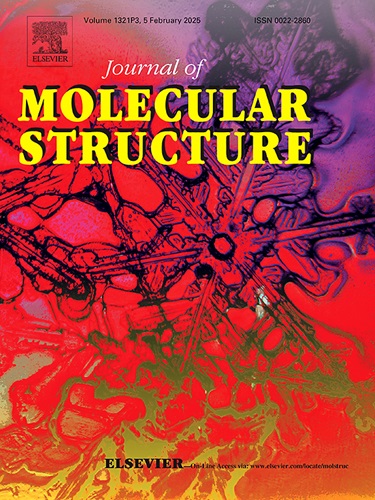卤化物调节的汞(II)配位聚合物对青霉素表现出不同的电化学生物感应
IF 4
2区 化学
Q2 CHEMISTRY, PHYSICAL
引用次数: 0
摘要
通过3-(2-吡啶基)-4,5-双(3-吡啶基)-1,2,4-三唑(L233)与不同的无机汞(II)盐(即HgCl2、HgBr2或HgI2)的组装,制备了一系列汞(II)配位聚合物(CPs),即[Hg2(L233)(Cl)4]n(1)、[Hg(L233)(Br)2]n(2)和[Hg(L233)(I)2]n(3))。单晶x射线衍射结果表明,化合物1-3具有不同的一维配位网络,可作为青霉素类抗生素检测的电化学传感平台。采用循环伏安法(CV)和电化学阻抗谱法(EIS)对其电化学性能进行表征。其中,配合物1对青霉素具有较好的传感性能。本文章由计算机程序翻译,如有差异,请以英文原文为准。
Halide-regulated Mercury (II) coordination polymers showing diverse electrochemical biosensing toward penicillin
A series of mercury (II) coordination polymers (CPs), namely, [Hg2(L233)(Cl)4]n (1), [Hg(L233)(Br)2]n (2), and [Hg(L233)(I)2]n (3) were prepared by assembly of 3-(2-pyridyl)-4,5-bis(3-pyridyl)-1,2,4-triazole (L233) with different inorganic Hg(II) salts (i.e., HgCl2, HgBr2 or HgI2). Single-crystal X-ray diffraction indicates that compounds 1–3 display diverse 1D coordination networks and were employed as electrochemical sensing platforms for the detection of penicillin antibiotics. Cyclic voltammetry (CV) and electrochemical impedance spectroscopy (EIS) were performed to characterize their electrochemical properties. Among these compounds, complex 1 exhibited superior sensing performance toward penicillin.
求助全文
通过发布文献求助,成功后即可免费获取论文全文。
去求助
来源期刊

Journal of Molecular Structure
化学-物理化学
CiteScore
7.10
自引率
15.80%
发文量
2384
审稿时长
45 days
期刊介绍:
The Journal of Molecular Structure is dedicated to the publication of full-length articles and review papers, providing important new structural information on all types of chemical species including:
• Stable and unstable molecules in all types of environments (vapour, molecular beam, liquid, solution, liquid crystal, solid state, matrix-isolated, surface-absorbed etc.)
• Chemical intermediates
• Molecules in excited states
• Biological molecules
• Polymers.
The methods used may include any combination of spectroscopic and non-spectroscopic techniques, for example:
• Infrared spectroscopy (mid, far, near)
• Raman spectroscopy and non-linear Raman methods (CARS, etc.)
• Electronic absorption spectroscopy
• Optical rotatory dispersion and circular dichroism
• Fluorescence and phosphorescence techniques
• Electron spectroscopies (PES, XPS), EXAFS, etc.
• Microwave spectroscopy
• Electron diffraction
• NMR and ESR spectroscopies
• Mössbauer spectroscopy
• X-ray crystallography
• Charge Density Analyses
• Computational Studies (supplementing experimental methods)
We encourage publications combining theoretical and experimental approaches. The structural insights gained by the studies should be correlated with the properties, activity and/ or reactivity of the molecule under investigation and the relevance of this molecule and its implications should be discussed.
 求助内容:
求助内容: 应助结果提醒方式:
应助结果提醒方式:


